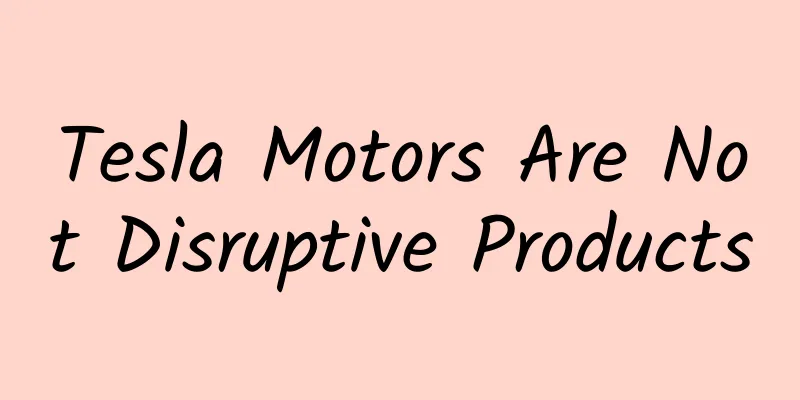Tesla Motors Are Not Disruptive Products

|
When I was reading The Innovator's Dilemma, the book described the development of electric vehicles in detail at the end, which was basically the same except for Tesla's situation. Although Tesla's sales volume was not large after its appearance, it had a great impact. However, I recently read some reports and finally found that Tesla did not escape the theory described in this book, and Tesla's final result was actually predictable. Comparing some key technologies used by Tesla and traditional fuel vehicles, electric vehicles use battery technology and electric motors, while fuel vehicles use engines and gearboxes. The technical differences are very large, so it can be said that electric vehicles are a revolutionary technology for fuel vehicles. However, revolutionary technology does not mean revolutionary products. Tesla's target users are those who can afford or are using high-end fuel vehicles, which means that Tesla is not a revolutionary product. After so many years of development, the technology of traditional cars is basically mature, with high user acceptance, powerful performance, easy use, and low price. If we want current car users to accept electric cars, then electric cars must be more powerful than traditional cars, more convenient to use, more reliable, cheaper, and have lower life cycle costs. Tesla's advantages: The energy source is electricity, which is environmentally friendly, which is also the most important performance feature of Tesla. Low maintenance cost. The built-in software is powerful. Tesla's disadvantages: Charging is very inconvenient. Expensive. The battery cannot last as long as the vehicle, and the cost of use is high. Analyze the above advantages and disadvantages, and evaluate the product from four aspects: function, reliability, convenience and price. The main function of a car is safe driving. Tesla has no special advantage over fuel cars in this regard. Tesla specifically pointed out that the ability to start quickly has an impact on safety, which is an oversupply of functions; the powerful built-in software has no effect on ordinary users, but when switching products, there will be great dangers due to the large changes. Ordinary users do not care about environmental issues. In terms of reliability, the characteristics of the battery determine that it is very dangerous. From the 7 spontaneous combustion accidents of Tesla, it can be seen that Tesla's safety is worse than that of fuel cars. Some people may say that Tesla should be given time to improve and improve. This is the problem. In a market where there are better products that can replace current products, users will not care about the gradual improvement of technology. Looking at the convenience of use, charging requires a site, a dedicated line, and a long time. Tesla has no hope of surpassing fuel cars in this regard, and it will not be seen in the foreseeable future. From a fundamental point of view, battery charging is a chemical reaction, and chemical reactions cannot be completed quickly. In terms of price, Tesla is far away from ordinary users. It is a special product for high-end users, and the battery is very expensive to use. Overall, Tesla's entire life cycle cost is high and far away from ordinary users. Tesla wants to transplant a disruptive technology into the value system of existing products, and hopes to defeat the traditional value system through disruptive technology. This mistake has happened many times and is happening in many industries, such as BlackBerry's failure in mobile phones, Intel's failure in mobile devices, and Seagate's upcoming failure in the hard disk market. The value system of this product determines that Tesla has no competitiveness in the current automobile market. The same is true for electric vehicles launched by BMW, Mercedes-Benz, etc. These products will once again verify the theory of disruptive innovation. Tesla is not a disruptive technology product, but it does not mean that electric vehicles are not a disruptive technology. Everyone should have a deep impression of electric bicycles. After the appearance of electric bicycles, all fuel motorcycles were immediately swept out of the market. Now there are many kinds of electric vehicles, such as electric three-wheeled motorcycles and slow electric vehicles. The appearance of these devices is basically outside the mainstream market, but the market growth in rural areas and urban-rural fringe areas is very rapid. The use scenario of slow electric vehicles is for users who originally could not afford or felt that cars were too expensive. These users do not have a real feeling of the advantages of fuel vehicles, because if there are no cheap slow electric vehicles using lead-acid batteries, there will be no cars to drive. The characteristics of this type of car are that the functions are basically sufficient, the price is low, and it is very economical to use. In terms of Tesla's fatal convenience of use, these cars can be charged using 220V mains electricity, without a dedicated circuit, and can generally be charged in their own yard. For these users, it doesn't matter if the charging is slow, the price is the most important. These companies that produce slow electric vehicles are beginning to move towards higher-end markets, from the previous electric tricycles with sheds to the current lowest-end electric vehicles. They are not in competition with mainstream car dealers. In the future, mainstream car dealers will be happy to give up the market of the lowest-end fuel vehicles to the slow electric vehicle market, because this market is not profitable for fuel vehicle manufacturers. And because higher-end products will have higher profits, these slow electric vehicle manufacturers will attack the high-end market little by little, and eventually meet the requirements of mainstream vehicles with continuous slow technological breakthroughs. At this time, the low-price characteristics of existing slow electric vehicles will be retained. Mainstream car manufacturers will focus on traditional fuel vehicles due to low profit issues. Their value system cannot reduce the entire life cycle cost, and they are simply unable to resist this low-price attack, and will give up all the market share that electric vehicles can reach. This is the key description of disruptive technology in "The Innovator's Dilemma". Generally, destruction starts from non-mainstream unexpected markets. It is unwise to consider electric vehicles from an environmental perspective. After all, power generation produces no less air pollution, especially in China, a market dominated by coal-fired power plants, where pollutants are simply transferred. Plug-in hybrid vehicles are a good choice, with low overall fuel consumption and performance that meets the requirements of the mainstream market. The main problem now is that the cost of plug-in hybrid vehicles is too high. Consider it the other way around. The main cost of electric vehicles comes from lithium batteries. Then, reducing the use of lithium batteries, replacing them with an engine with a generator, removing the gearbox, and having no transmission device, with high reliability and easy maintenance, will reduce the cost of the entire plug-in hybrid vehicle to a level acceptable to the mainstream market. This will be the direction of mainstream cars. As a winner of Toutiao's Qingyun Plan and Baijiahao's Bai+ Plan, the 2019 Baidu Digital Author of the Year, the Baijiahao's Most Popular Author in the Technology Field, the 2019 Sogou Technology and Culture Author, and the 2021 Baijiahao Quarterly Influential Creator, he has won many awards, including the 2013 Sohu Best Industry Media Person, the 2015 China New Media Entrepreneurship Competition Beijing Third Place, the 2015 Guangmang Experience Award, the 2015 China New Media Entrepreneurship Competition Finals Third Place, and the 2018 Baidu Dynamic Annual Powerful Celebrity. |
<<: Tim Cook's coming out statement: A carefully planned declaration of a new era for Apple
>>: Even with FDD licenses, China Unicom and China Telecom still cannot beat China Mobile
Recommend
Improper makeup application may cause dry eyes! What's going on?
See this title Some girls may be surprised: I'...
WM Motor's new energy vehicles were cancelled due to battery problems, which not only overdrawn consumers' confidence in the industry
A Mustang new energy vehicle caught fire while cha...
2022 Taobao Live 618 Event Guide!
618 is approaching, and various platforms have be...
Why is hairy crab the first delicacy in autumn?
Written by Wei Shuihua Header Image | Who is the ...
Teach you step by step how to create popular internet celebrity food
For us now, eating is no longer a simple matter o...
The world's first OpenAI robot was born, which can interact with people autonomously丨Tech Weekly
Compiled by Zhou Shuyi and Wang Xiang Starship su...
It has suddenly become popular recently, and the flames jumped to nearly 5 meters in 3 seconds! Don't follow the trend!
Near Chinese New Year Netizens' "fancy a...
A practical guide to building a high-stickiness private domain operation system
If 2019 is called the "first year" of t...
Zhihu's "Seven-Day Unconditional Refund" disrupts knowledge payment: Come on, let's hurt each other
On that special train to April, to the springtime...
Let’s talk about 5 aspects: How to do brand cross-border marketing?
Cross-border marketing is the process of combinin...
Do your joints make "cracking" sounds when you move? Your body is "speaking", but many people don't know it
Reviewer of this article: Chen Haixu, Deputy Dire...
Another wave of confusing place names: "Changchun" is not spring-like all year round, and "Mudanjiang" has no peonies
This article is about 3000 words Reading time: 8 ...
APP practical information: How to become a content operator from scratch!
At an accidental Shanghai (Smalltalk) operations ...
Mobile Internet Marketing Director Operation and Promotion Planning Case
In recent years, mobile Internet has developed ra...









